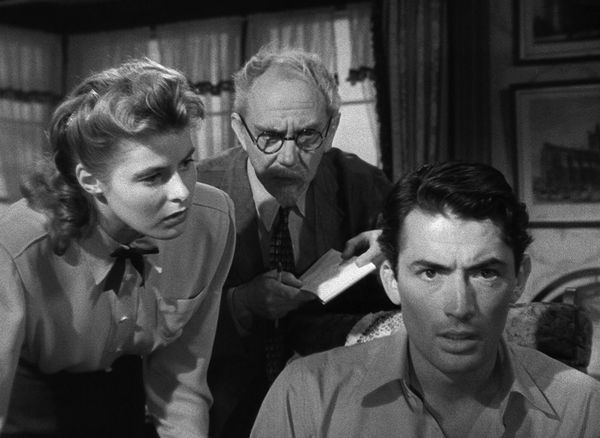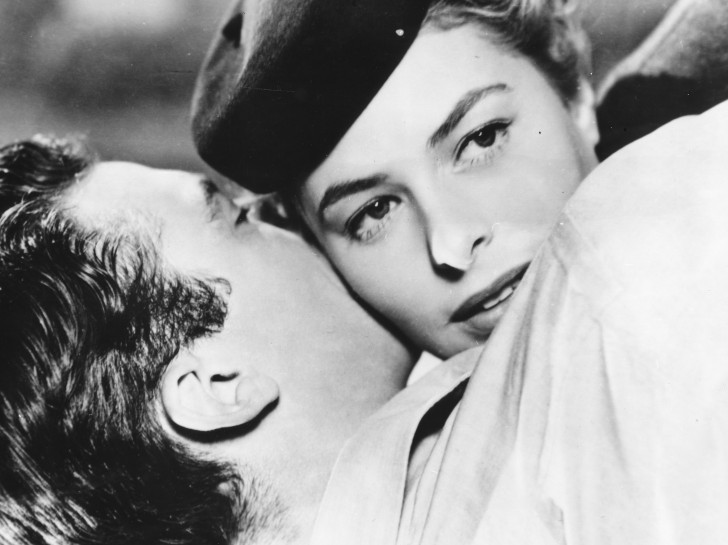
Spellbound is fabulous as a film in itself and if you want to get a feel for the history of amnesia in cinema.
Directed by Alfred Hitchcock, this brilliant psychological thriller is based on a novel, The House of Doctor Edwards (1927) by Hilary Saint George Saunders under the pseudonym with another author, Francis Beeding (see below).
Starring Ingrid Bergman as a psychoanalyst and Gregory Peck as the amnesiac, Spellbound is famed for its Freudian themes, its dream sequences with imagery by Salvador Dali and its heightened sense of menace.
When Dr. Anthony Edwardes (Gregory Peck) arrives at a mental hospital in Vermont to replace the outgoing hospital director, a psychoanalyst, Dr. Constance Peterson (Ingrid Bergman), discovers Edwardes is an impostor. The man confesses that the real Dr. Edwardes is dead and fears he may have killed him, but cannot recall anything. Realising he has amnesia, Dr. Peterson becomes convinced he is innocent of the missing man’s murder and joins him on a quest to unravel his amnesia through psychoanalysis.
Petersen wants to psychoanalyse him to break through his amnesia and uncover his memories but has to track him down first as driven by guilt, he had gone missing, hiding in New York. Pursued by the police through Grand Central Station, they take a train to stay with Petersen’s former mentor, Dr. Alexander Brulov. The two doctors analyse the amnesiac man’s dream, concluding that his phobia of dark lines on white is based on ski tracks in the snow. They suggest the older man in his dream is the real Dr. Edwardes, and he was killed in a skiing accident.
After the film’s release, it broke every record in London, in both famous theaters, Pavilion and Tivoli Strand, for a single day, week, month, holiday and Sundays.

Spellbound review from history
Excerpt from The New York Times review from 1946 1
Quote from the review:
“Mr. Hitchcock has used some startling images to symbolize the content of dreams—images designed by Salvador Dali. But his real success is in creating the illusion of love. Miss Bergman, as we say, is his chief asset in accomplishing the sincerity of this film, but Mr. Peck is also a large contributor. His performance, restrained and refined, is precisely the proper counter to Miss Bergman’s exquisite role. Michael Chekhov is likewise responsible for some of the excellent humor in this film, playing an elderly psychiatrist and an accomplice in Miss Bergman’s mental “chase.””


The House of Dr. Edwardes

Hilary Saint George Saunders was a British author, known for his war books and pamphlets, who wrote under several noms-de-plume. The House of Dr. Edwardes is a psychological thriller in novel form written by John Palmer and Hilary A. Saunders under the pseudonym Francis Beeding.
Hitchcock pulled out the best of this melodramatic book and created a film noir masterpiece. The plot concerns a psychiatrist at an asylum which is about to get a new director. The new man is attracted to Dr. Constance Sedgwick, who discovers eventually that he is not what he claims to be.
Good Reads reviewer says:
“Fans of Hitchcock will want to take special notice of ‘The House of Dr. Edwardes’, for, unlike other adaptations, ‘Spellbound’ strays rather dramatically from its source material. Not only do the differences offer fascinating peeks into the great director’s creative vision, they also ensure that even Hitchcock fans familiar with ‘Spellbound’ will find much in Beeding’s novel that will surprise and delight.”